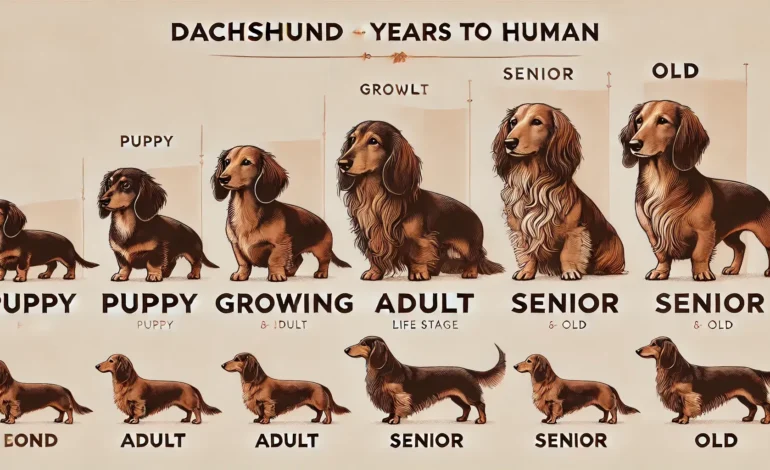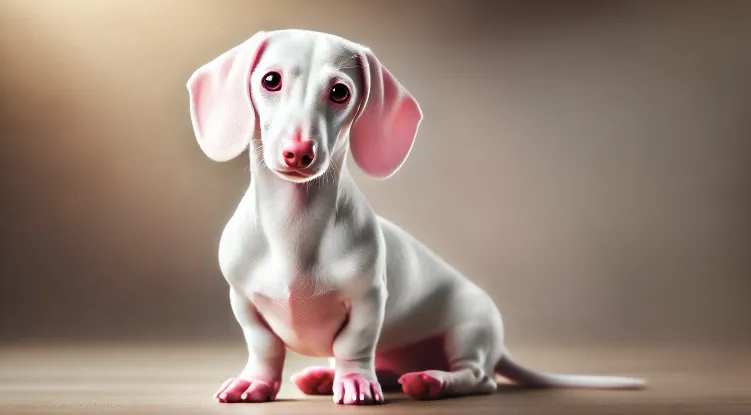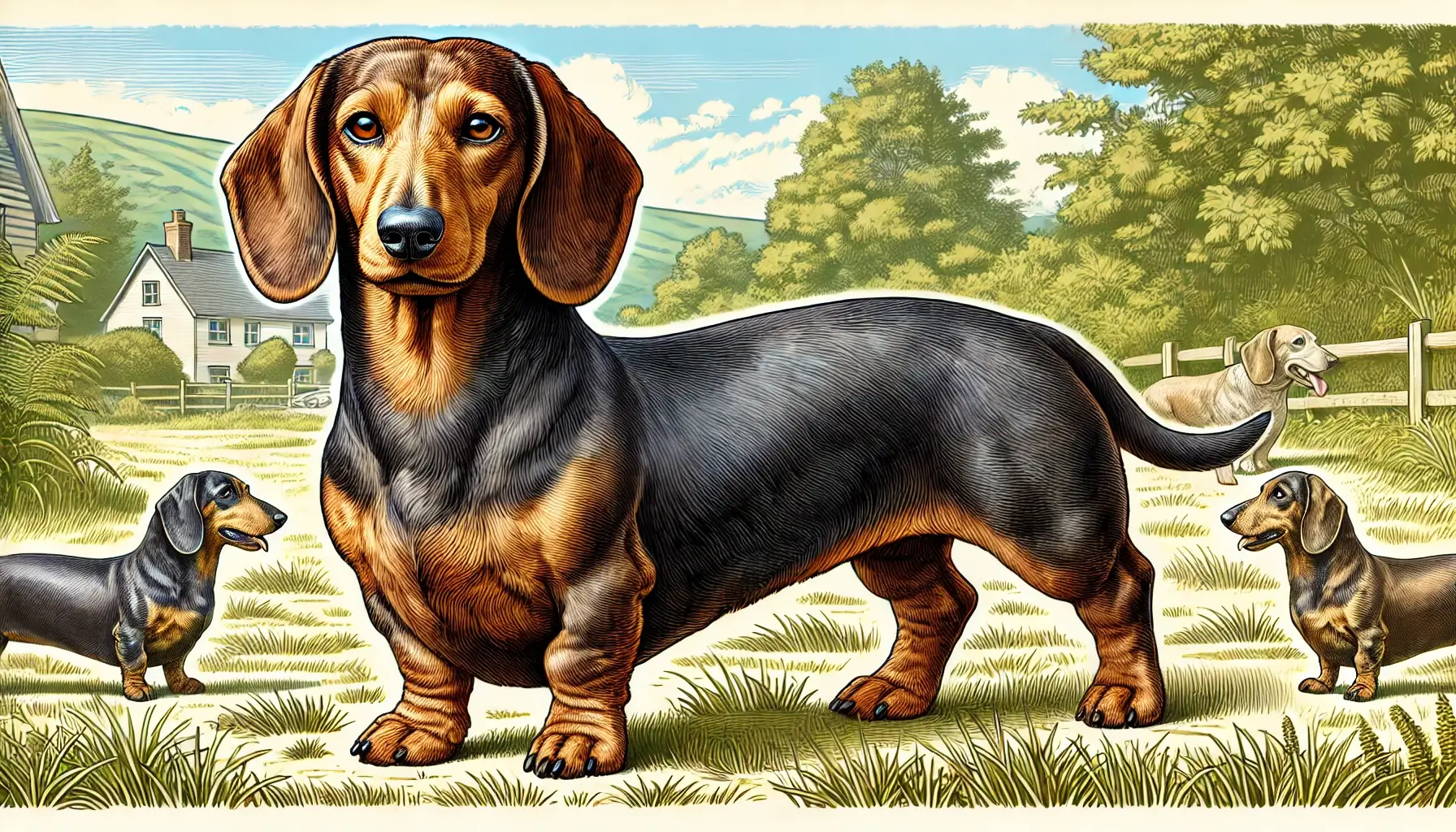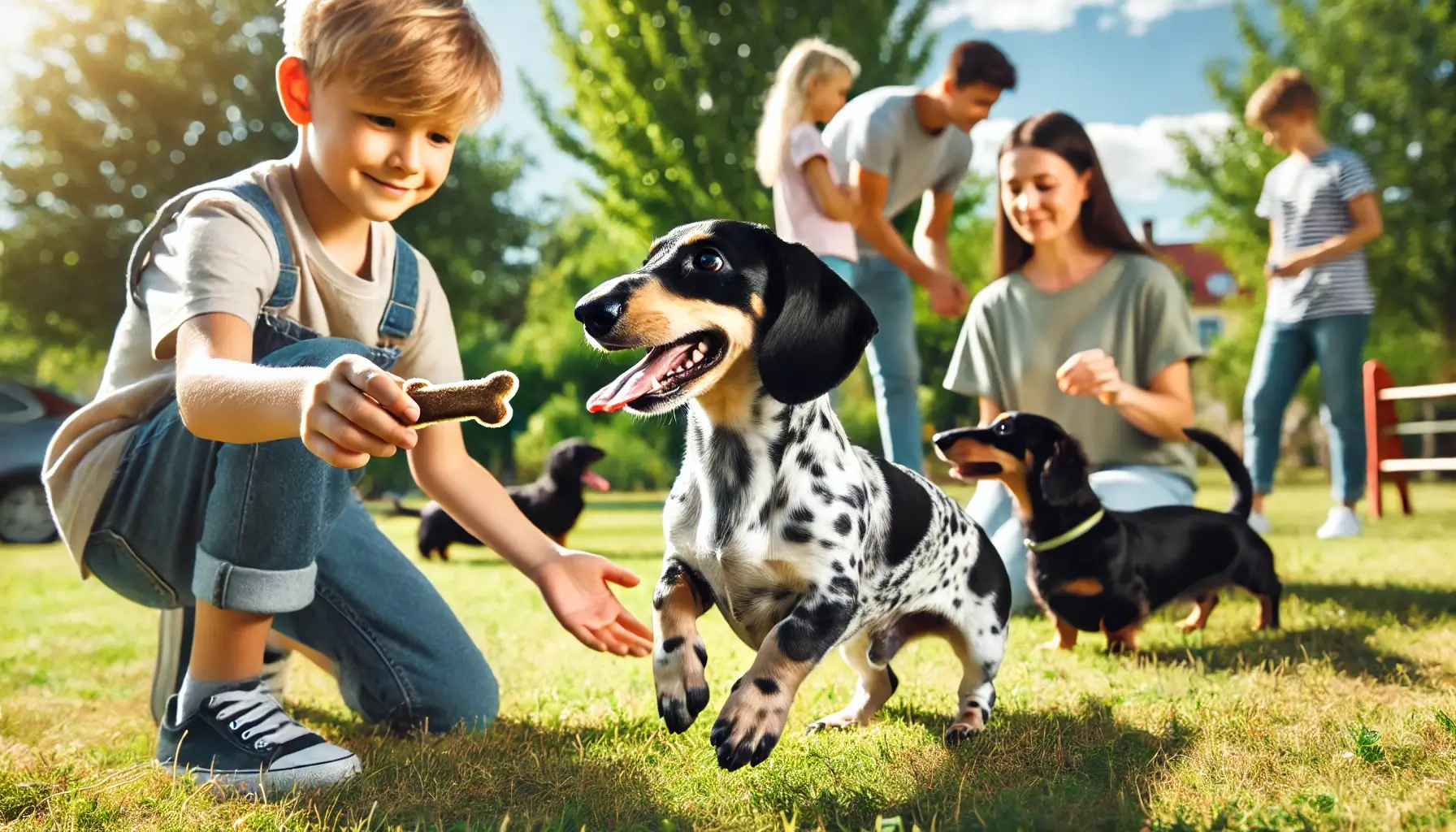
Dachshund Dog Years To Human: How to Calculate your Dachshund’s Age?
Dogs age much faster than humans, with the average lifespan of a dog ranging from 10 to 13 years, depending on factors like breed, size, and health.
While there is a common belief that equates dog years to human years, this is only partially accurate. Different breeds age at different rates, and smaller dogs generally live longer than larger ones.
So, What is the dachshund age in human years?
The Mini dachshund dog years to human for the first 2 years equates to approximately 24 human years. After this, each additional year is roughly equal to 4-5 human years. For example, a 3-year-old Dachshund would be about 28 human years old, while a 7-year-old is closer to 44 human years.
In this article, we will discuss the importance of understanding your Dachshund’s age in human years, how this knowledge can improve their care, and what it means for their overall health. Let’s get started!
Quick Dachshund Dog Years To Human Calculator
We’ve created our very own Dachshund Dog Years to Human Calculator to make it easy for you to figure out your furry friend’s age in human years. Whether you’re curious about how old your Dachshund is compared to you, or want to calculate a future age, our calculator does all the work.
It’s simple—just input your Dachshund’s current age, and the tool will instantly convert it into human years using breed-specific data. No need to guess or rely on outdated formulas like the “7 dog years equals 1 human year” myth. Our calculator takes into account the unique aging process of Dachshunds for more accurate results.
Go ahead, try it out, and discover how your Dachshund’s age measures up in human years!
Dachshund Dog Years to Human Years Calculator
Or, you can see the quick table:
| Dachshund Age (Years) | Human Equivalent Age (Years) |
| 1 | 15 |
| 2 | 24 |
| 3 | 28 |
| 4 | 32 |
| 5 | 36 |
| 6 | 40 |
| 7 | 44 |
| 8 | 48 |
| 9 | 52 |
| 10 | 56 |
| 11 | 60 |
| 12 | 64 |
| 13 | 68 |
| 14 | 72 |
| 15 | 76 |
| 16 | 80 |
| 17 | 84 |
| 18 | 88 |
| 19 | 92 |
| 20 | 96 |
How Dog Years Are Traditionally Calculated?
For years, we’ve all heard the classic formula: 1 dog year equals 7 human years. It’s a simple idea that’s stuck around for a while, but like most myths, it’s not entirely accurate.
The belief likely started as an easy way to estimate a dog’s lifespan compared to ours, considering that dogs typically live shorter lives than humans.
However, it’s outdated now because it doesn’t take into account the breed or size of the dog, which are huge factors in how they age.
The truth is, smaller breeds like Dachshunds tend to live longer than larger breeds like Great Danes, and they also age at different rates.
For example, a Dachshund will mature faster in its first couple of years but slow down in later years, while a larger breed ages more steadily. This is why you can’t really rely on that simple 1:7 ratio anymore.
Genetics play a role in a dog’s aging process, so understanding how your specific dog, like a Dachshund, ages will give you a much clearer picture of their actual age in human years.
The Science Behind Dog Aging
Science has helped us understand so much about the world around us, and now, it’s even possible to pinpoint the aging process of our pets, including dogs.
For instance, the Dog Aging Project gathered data from over 47,000 dogs to better understand aging in different breeds. This allows us to more accurately calculate a dog’s age in human years, especially for specific breeds like the Dachshund.
This study, led by veterinarians at Texas A&M, focused on understanding how dogs like Dachshunds age. The team worked with dog owners to track health data and collect samples to study biomarkers of aging. Their findings confirmed that smaller breeds, like Dachshunds, age more slowly compared to larger dogs after the first few years.
Some Accurate Methods To Calculate Dachshund Dog Years To Human
To get a more accurate picture of how Dachshunds age, researchers have moved beyond the simple “1 dog year equals 7 human years” myth. Two methods now stand out:
- Logarithmic Scaling: This method suggests that dogs age rapidly in their first two years and then much slower afterward. For example, a 2-year-old Dachshund might be equivalent to a 21-year-old human, but from there, they age about 4-5 human years for every additional dog year.
- First Two Years Method: This method emphasizes that the first two years of a dog’s life are crucial for their development and represent the most rapid aging. After those initial years, the aging process slows significantly, especially in smaller breeds like Dachshunds.
By understanding these methods, you can better track your Dachshund’s age and adjust their care accordingly to ensure they live a long, healthy life.
Dachshund Dog Years To Human: Complete Life Years Calculation
Let’s realistically convert Dachshund dog years into human years, assuming a total lifespan of 23 years for our Dachshund. We’ll go through each life phase—Miniatur, Adulthood, and Senior Years—to see how old your Dachshund would be in human years at every stage.
Miniature Dachshund Dog Years to Human Years (0-2 years)
The first two years of a Dachshund’s life are crucial for their development and growth, equating to rapid aging in human terms. During this time, a Dachshund matures quickly, much like a human moving from infancy to young adulthood.
Year 1 (15 human years)
One year in dog year for Dachshund is equivalent to a 15-year-old human. This is a period of rapid growth and learning, where they are full of energy and curiosity, much like a teenager.
Year 2 (24 human years)
By the second year, your Dachshund has matured into an adult and is approximately 24 in human years. They’ve reached physical maturity, but mentally they still have plenty of learning ahead.
Adulthood (2-7 years)
Once Dachshunds reach two years, their aging process slows down considerably. During their prime years (2-7), they remain active and healthy, with slower physical aging compared to their earlier years.
Year 3 (28 human years)
At age three, your Dachshund would be around 28 human years old. They are in the prime of their adult life, strong, active, and still learning new things, but with greater self-control than in earlier years.
Year 4 (32 human years)
Your four-year-old Dachshund is like a 32-year-old human—still very much in their prime. They are likely very comfortable with their routine and are physically active, enjoying regular exercise.
Year 5 (36 human years)
At five years old, your Dachshund equates to a 36-year-old human. They may start slowing down a little but remain highly energetic and playful. At this age, they are well-settled in their adult personality.
Year 6 (40 human years)
By year six, your Dachshund is about 40 in human years. While they’re still active, you might notice a slower recovery from intense exercise or more time spent resting after playtime.
Year 7 (44 human years)
At seven years, your Dachshund is entering middle age, equivalent to a 44-year-old human. This is when they may begin showing early signs of aging, such as greying fur or a little more reluctance to engage in strenuous activities.
Senior Years (7+ years)
From year 7 onward, your Dachshund enters their senior phase. Just like humans, older dogs require more care and attention. This phase is marked by slower movements, potential health issues, and a need for more gentle exercise and care.
Let’s break down each year of seniorhood into human equivalents:
Year 8 (48 human years)
Eight-year-old Dachshunds are roughly 48 human years old. They might slow down noticeably and need more time to rest, but they still have plenty of love and energy to share with the family.
Year 9 (52 human years)
Your Dachshund at nine is around 52 in human years. This is a time when regular vet checkups are important to monitor for common age-related health issues, like arthritis or dental problems.
Year 10 (56 human years)
At ten, your Large Dachshund is about 56 human years old. They are likely less active and more prone to taking naps, but proper diet and gentle exercise are key to keeping them healthy.
Year 11 (60 human years)
By year eleven, your Dachshund is approximately 60 in human years. They’re a true senior now, requiring extra care, including comfortable bedding and shorter walks to accommodate their aging joints.
Year 12 (64 human years)
At 12 years old, your Dachshund is 64 in human years. You might notice more signs of aging such as slower movements and the onset of some health problems, but with the right care, they can still live happily.
Year 13 (68 human years)
At 13 years, your Dachshund is 68 human years old. This is a critical stage where health monitoring becomes more frequent, focusing on joint health, heart condition, and cognitive function.
Year 14 (72 human years)
At fourteen, your Dachshund is around 72 human years old. They may start to lose some senses like hearing or vision, but with a supportive environment, they can still have a good quality of life.
Year 15 (76 human years)
At fifteen, your Dachshund is roughly 76 in human years. This is considered advanced age for most dogs, and they may require assistance with daily activities like climbing stairs or getting into their bed.
Year 16 (80 human years)
At 16 years old, your Dachshund is equivalent to an 80-year-old human. They will be spending more time resting, and ensuring they are comfortable is key to their well-being at this stage.
Year 17 (84 human years)
By year seventeen, your Dachshund is about 84 in human years. They are likely to need more frequent vet visits, and you may notice cognitive changes like forgetfulness or confusion.
Year 18 (88 human years)
At eighteen, your Dachshund is 88 in human years. Mobility may be limited, and a calm, supportive environment becomes more important to ensure their comfort and happiness.
Year 19 (92 human years)
Nineteen years old for a Dachshund is equivalent to 92 human years. At this advanced age, they will need significant care, with focus on managing any pain and ensuring they enjoy their twilight years.
Year 20 (96 human years)
At 20 years, your Dachshund is about 96 in human years. By now, they will be extremely elderly and may require special assistance with mobility and daily care routines.
Year 21 (100 human years)
At 21 years old, your Dachshund reaches a significant milestone, equivalent to 100 human years. At this stage, every day is a blessing, and they’ll need your full attention to stay comfortable and content.
Year 22 (104 human years)
At 22, your Dachshund is around 104 human years. This stage will likely involve a lot of rest, as they’ve lived a long, full life. Comfort and love are key.
Year 23 (108 human years)
If your Dachshund reaches 23, they are about 108 in human years. This is an extremely rare age for a dog, and they’ll require the utmost care, attention, and affection to enjoy their final days.
How to Prolong Your Dachshund’s Lifespan?
Prolonging your Dachshund’s life isn’t rocket science, but it does require paying attention to the little things that can make a big difference. From keeping their weight in check to preventing common breed-specific issues, here’s what you should focus on:
- Feed smart: Stick to a lean, protein-rich diet without unnecessary fillers. Overweight Dachshunds are at higher risk of back problems, so cut down on treats and keep portions controlled.
- Daily, moderate exercise: They might be small, but Dachshunds love to move. Daily walks (15-30 minutes) are great, but avoid strenuous jumping or rough play to protect their spine.
- Prevent back issues: Dachshunds are notorious for spine problems like intervertebral disc disease (IVDD). Use ramps for furniture, avoid letting them jump off high places, and opt for harnesses instead of collars for walking.
- Vet check-ups on point: Don’t skip those routine vet visits. Regular screenings for common issues like dental disease, heart conditions, coat-related problems, and joint problems can catch things early before they become big (and expensive) issues.
- Dental care matters: Brush their teeth regularly, or at least use dental chews. Dachshunds are prone to gum disease, which can lead to other health problems.
- Mental stimulation: Keep their brain active with puzzle toys, scent games, or training tricks. A bored Dachshund is more likely to develop anxiety or destructive behavior.
Frequently Asked Questions (FAQs)
How old is a Dachshund in human years?
A Dachshund’s age in human years depends on their actual age, but typically by year two, they are around 24 human years old, with each subsequent year equating to 4-5 human years.
How old is a 3-year-old Dachshund?
A 3-year-old Dachshund is approximately 28 years old in human years.
Can a Dachshund live for 20 years?
Yes, while rare, Dachshunds can live up to 20 years with excellent care and attention to their health.
Is a 7-year-old Dachshund old?
A 7-year-old Dachshund is considered middle-aged, equivalent to about 44 human years.
Conclusion: Dachshund Dog Years to Human
This article explored how to accurately calculate your Dachshund’s age in human years, debunking the outdated “7 dog years” rule.
With a clearer understanding of their unique aging process, you can now better determine what stage of life your Dachshund is in and adjust their care to match. We’ve also provided a calculator to make it easy to see how old your Dachshund is in human years.
While Dachshunds typically live 12-20 years, there are ways to extend their lifespan through simple lifestyle adjustments like regular vet visits, a balanced diet, daily exercise, and, of course, plenty of love.





